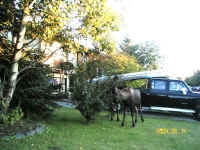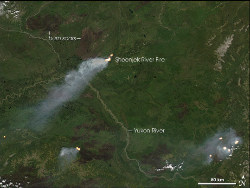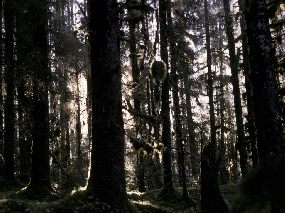Alaska

Wildlife photo of two twins in our Alaska home's front
yard. - Don Bertolette, Sept 04, 2004 |

Alaskan forest fires |
 Alaska
Alaska
On March 14, 2010 the Eastern Native Tree
Society and Western Native Tree Society switched from discussion lists
on Google Groups to a new discussion list in a Bulletin Board format at:
http://www.ents-bbs.org/index.php Posts made since the inception
of the BBS on March 14, 2010 will be sorted and archived on the BBS.
Click on the link to go to the equivalent section on the new BBS. This
website will continue to serve as a front end for the ENTS and WNTS
groups. It will continue to serve as a repository of older posts, and
will serve as the host site for special projects and features that are
not well suited for a BBS format. Please visit the BBS for the latest
information and trip reports.
 Alaska
State Register of Big Trees
Alaska
State Register of Big Trees
Field Trips
 Glacier Bay National
Park http://www.nps.gov/glba/index.htm
The park has snow-capped mountain ranges rising to over 15,000 feet, coastal beaches with protected coves, deep fjords, tidewater glaciers, coastal and estuarine waters, and freshwater lakes. These diverse land and seascapes host a mosaic of plant communities ranging from pioneer species in areas recently exposed by receding glaciers, to climax communities in older coastal and alpine ecosystems. Diverse habitats support a variety of marine and terrestrial wildlife. As is the case throughout much of Southeast Alaska, temperate rainforest dominates the southern part of Glacier Bay National Park. The “high biological productivity” or ability of many plants to live in this coastal area is due to the mild, moist climate that has developed in the region over the past 200-300 years. This is an old growth forest with massive evergreen trees like western hemlock and Sitka spruce that drip with lichens and mosses, and a thick layer of vegetation such as blueberries, fungi, liverworts and wildflowers that blankets the forest floor. The sheer quantity of things living or that once lived but are now decaying means that this type of forest produces some of the largest accumulations of organic material on earth.
Glacier Bay National
Park http://www.nps.gov/glba/index.htm
The park has snow-capped mountain ranges rising to over 15,000 feet, coastal beaches with protected coves, deep fjords, tidewater glaciers, coastal and estuarine waters, and freshwater lakes. These diverse land and seascapes host a mosaic of plant communities ranging from pioneer species in areas recently exposed by receding glaciers, to climax communities in older coastal and alpine ecosystems. Diverse habitats support a variety of marine and terrestrial wildlife. As is the case throughout much of Southeast Alaska, temperate rainforest dominates the southern part of Glacier Bay National Park. The “high biological productivity” or ability of many plants to live in this coastal area is due to the mild, moist climate that has developed in the region over the past 200-300 years. This is an old growth forest with massive evergreen trees like western hemlock and Sitka spruce that drip with lichens and mosses, and a thick layer of vegetation such as blueberries, fungi, liverworts and wildflowers that blankets the forest floor. The sheer quantity of things living or that once lived but are now decaying means that this type of forest produces some of the largest accumulations of organic material on earth.

Temperate Rainforest along the southwest coast of Alaska - photo by
the US National Park Service.
 Tongass National Forest, Alaska
http://gorp.away.com/gorp/activity/wildlife/topten_oldgrowth3.htm
The largest temperate rain forest in the United States, indeed in the world, is also the least protected. President Clinton recently declared a moratorium on roadbuilding in all the extensive roadless areas of the national forests — all, that is, except for the Tongass. This leaves a 17-million-acre sleeping giant, vulnerable to massive clear-cutting and irreparable erosion.
The forest really is a trackless wilderness, with only a modest 600 miles of trail, much of that hardly used. Most of the trails can be found near the small communities along the Inside Passage. Perhaps the forest is best experienced on the coastal islands. The Kootznoowoo Wilderness on Admiralty Island is a good pick to experience the spruce-hemlock rain forest with pockets of boggy muskeg.
Tongass National Forest, Alaska
http://gorp.away.com/gorp/activity/wildlife/topten_oldgrowth3.htm
The largest temperate rain forest in the United States, indeed in the world, is also the least protected. President Clinton recently declared a moratorium on roadbuilding in all the extensive roadless areas of the national forests — all, that is, except for the Tongass. This leaves a 17-million-acre sleeping giant, vulnerable to massive clear-cutting and irreparable erosion.
The forest really is a trackless wilderness, with only a modest 600 miles of trail, much of that hardly used. Most of the trails can be found near the small communities along the Inside Passage. Perhaps the forest is best experienced on the coastal islands. The Kootznoowoo Wilderness on Admiralty Island is a good pick to experience the spruce-hemlock rain forest with pockets of boggy muskeg.
 Tongass National
Forest, Alaksa, USDA Forest Service Site http://www.fs.fed.us/r10/tongass/ Tongass National
Forest, Alaksa, USDA Forest Service Site http://www.fs.fed.us/r10/tongass/
 Tongass
Firsthand: Small Visitor to a Giant Land Tongass
Firsthand: Small Visitor to a Giant Land
by Patricia Adams https://www.savebiogems.org/firsthand/
This summer I returned with my husband, John, NRDC's founder, to the
Tongass National Forest in southeast Alaska, the site of one of my first
NRDC trips 27 years ago. On the surface, not that much has changed.
Today as then, the Tongass still appears, as it did to John Muir,
"in the morning of creation."
 GORP- Alaksa
Wilderness Areas http://gorp.away.com/gorp/resource/us_wilderness_area/ak.htm
Aleutian Islands, Andreafsky, Arctic, Becharof, Bering Sea, Bogoslof,
Chamisso, Chuck River, Coronation Island, Denali, Endicott River, Forrester Island, Gates of the Arctic, Glacier Bay, Hazy Islands, Innoko, Izembek, Karta River, Katmai, Kenai, Kobuk Valley, Kootznoowoo (Admiralty Island National Monument), Koyukuk, Kuiu, Lake Clark, Maurelle Islands, Misty Fiords National Monument, Noatak,
Nunivak, Petersburg Creek-Duncan Salt Chuck, Pleasant/Lemusrier/Inian Island, Russell Fiord, St. Lazaria, Selawik, Semidi and
Simenof, South Baranof, South Etolin Island, South Prince of Wales, Stikine-LeConte, Tebenkof Bay, Togiak, Tracy Arm-Fords Terror,
Tuxedni, Unimak, Warren Island, West Chichagof-Yakobi, Wrangell-Saint Elias. GORP- Alaksa
Wilderness Areas http://gorp.away.com/gorp/resource/us_wilderness_area/ak.htm
Aleutian Islands, Andreafsky, Arctic, Becharof, Bering Sea, Bogoslof,
Chamisso, Chuck River, Coronation Island, Denali, Endicott River, Forrester Island, Gates of the Arctic, Glacier Bay, Hazy Islands, Innoko, Izembek, Karta River, Katmai, Kenai, Kobuk Valley, Kootznoowoo (Admiralty Island National Monument), Koyukuk, Kuiu, Lake Clark, Maurelle Islands, Misty Fiords National Monument, Noatak,
Nunivak, Petersburg Creek-Duncan Salt Chuck, Pleasant/Lemusrier/Inian Island, Russell Fiord, St. Lazaria, Selawik, Semidi and
Simenof, South Baranof, South Etolin Island, South Prince of Wales, Stikine-LeConte, Tebenkof Bay, Togiak, Tracy Arm-Fords Terror,
Tuxedni, Unimak, Warren Island, West Chichagof-Yakobi, Wrangell-Saint Elias.
|



